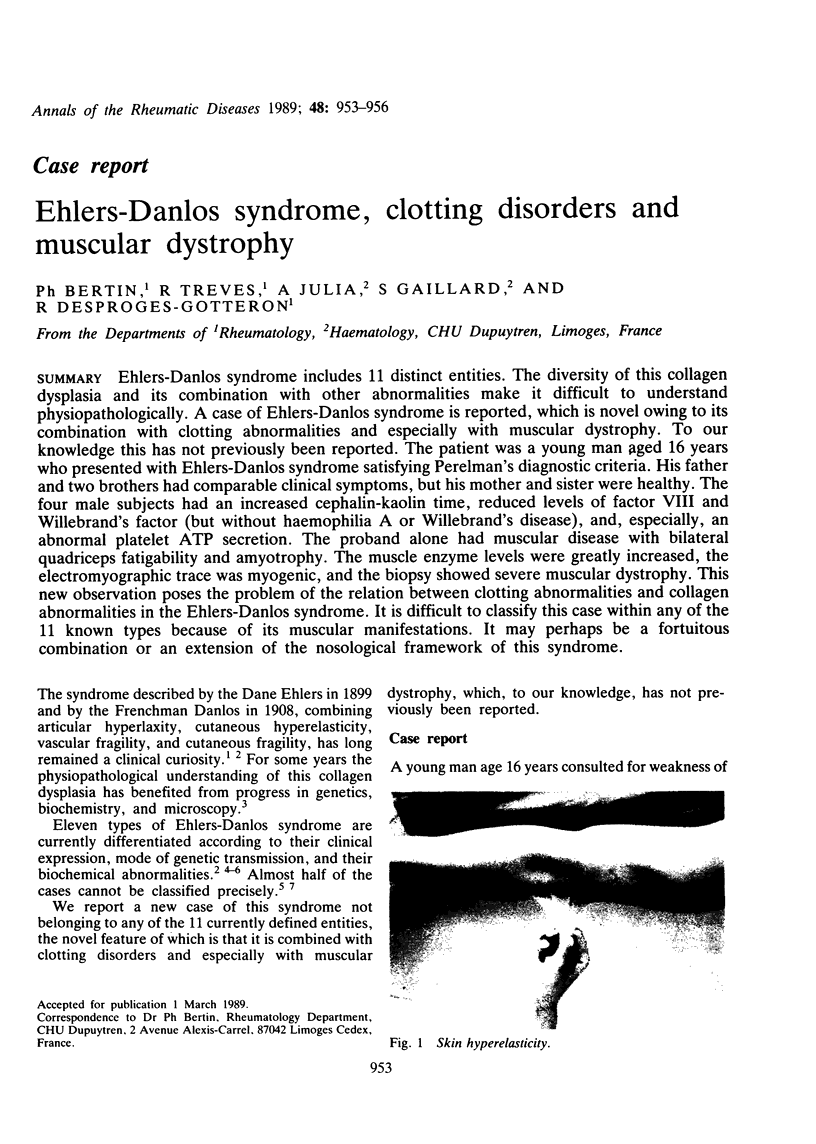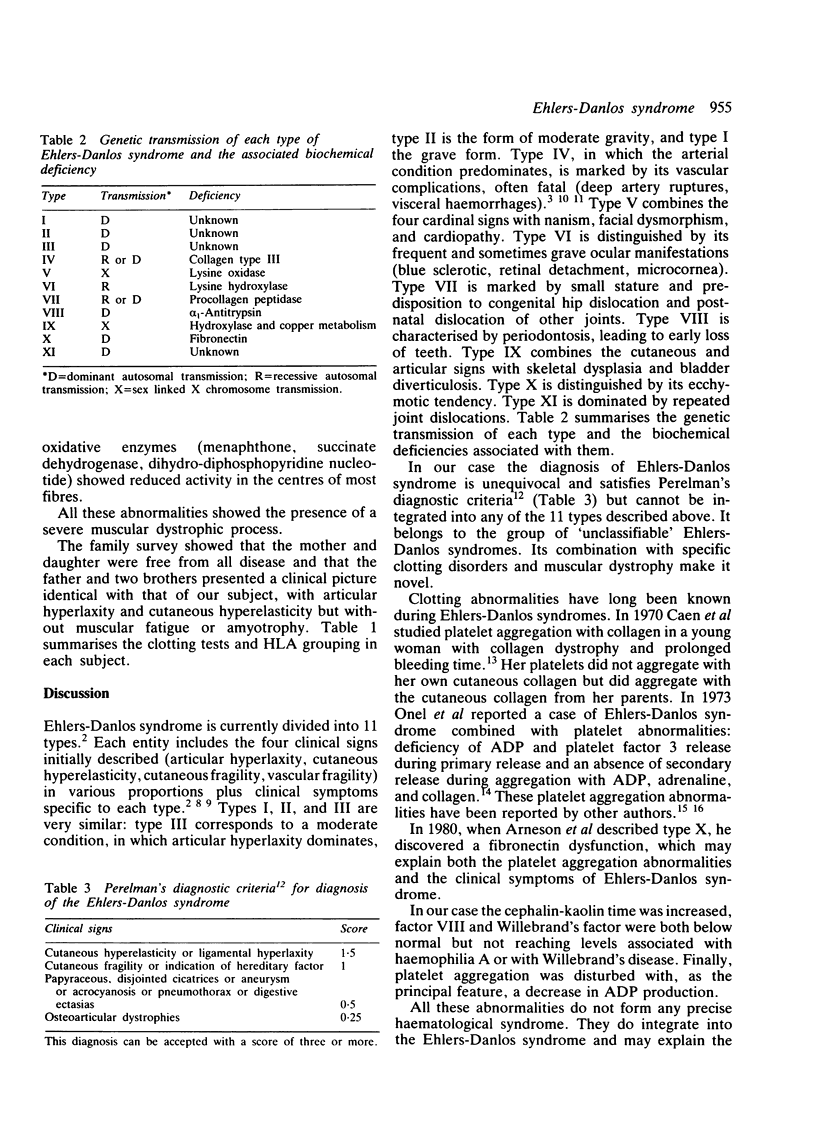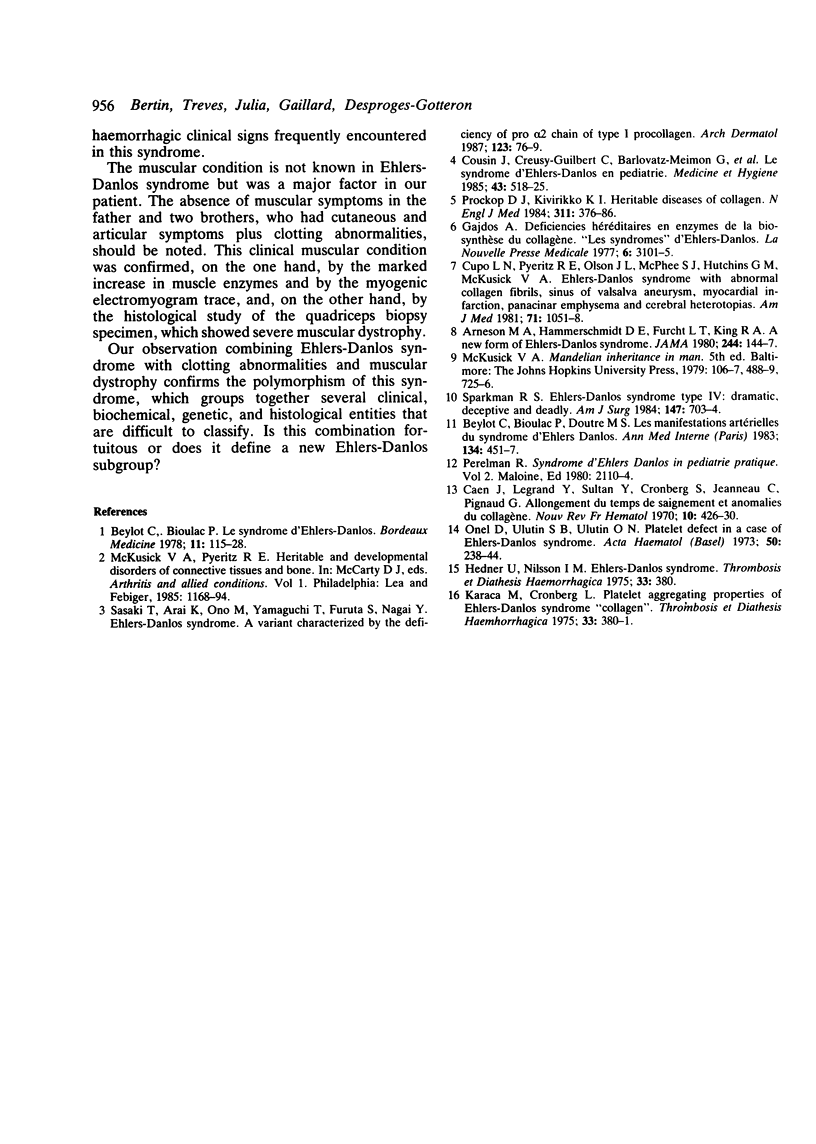Abstract
Ehlers-Danlos syndrome includes 11 distinct entities. The diversity of this collagen dysplasia and its combination with other abnormalities make it difficult to understand physiopathologically. A case of Ehlers-Danlos syndrome is reported, which is novel owing to its combination with clotting abnormalities and especially with muscular dystrophy. To our knowledge this has not previously been reported. The patient was a young man aged 16 years who presented with Ehlers-Danlos syndrome satisfying Perelman's diagnostic criteria. His father and two brothers had comparable clinical symptoms, but his mother and sister were healthy. The four male subjects had an increased cephalin-kaolin time, reduced levels of factor VIII and Willebrand's factor (but without haemophilia A or Willebrand's disease), and, especially, an abnormal platelet ATP secretion. The proband alone had muscular disease with bilateral quadriceps fatigability and amyotrophy. The muscle enzyme levels were greatly increased, the electromyographic trace was myogenic, and the biopsy showed severe muscular dystrophy. This new observation poses the problem of the relation between clotting abnormalities and collagen abnormalities in the Ehlers-Danlos syndrome. It is difficult to classify this case within any of the 11 known types because of its muscular manifestations. It may perhaps be a fortuitous combination or an extension of the nosological framework of this syndrome.
Full text
PDF



Images in this article
Selected References
These references are in PubMed. This may not be the complete list of references from this article.
- Arneson M. A., Hammerschmidt D. E., Furcht L. T., King R. A. A new form of Ehlers-Danlos syndrome. Fibronectin corrects defective platelet function. JAMA. 1980 Jul 11;244(2):144–147. [PubMed] [Google Scholar]
- Beylot C., Bioulac P., Doutre M. S. Les manifestations artérielles du syndrome d'Ehlers-Danlos. Ann Med Interne (Paris) 1983;134(5):451–457. [PubMed] [Google Scholar]
- Caen J., Legrand Y., Sultan Y., Cronberg S., Jeanneau C., Pignaud G. Allongement du temps de saignement et anomalies du collagène. Nouv Rev Fr Hematol. 1970 May-Jun;10(3):426–430. [PubMed] [Google Scholar]
- Cupo L. N., Pyeritz R. E., Olson J. L., McPhee S. J., Hutchins G. M., McKusick V. A. Ehlers-Danlos syndrome with abnormal collagen fibrils, sinus of Valsalva aneurysms, myocardial infarction, panacinar emphysema and cerebral heterotopias. Am J Med. 1981 Dec;71(6):1051–1058. doi: 10.1016/0002-9343(81)90341-7. [DOI] [PubMed] [Google Scholar]
- Gajdos A. Déficiences héréditaires en enzymes de la biosynthèse du collagène. "Les syndromes" d'Ehlers - Danlos. Nouv Presse Med. 1977 Oct 15;6(34):3101–3105. [PubMed] [Google Scholar]
- Hedner U. Letter: Platelet aggregating properties of Ehlers-Danlos syndrome "collagen". Thromb Diath Haemorrh. 1975 Apr 30;33(2):380–381. [PubMed] [Google Scholar]
- Onel D., Ulutin S. B., Ulutin O. N. Platelet defect in a case of Ehlers-Danlos syndrome. Acta Haematol. 1973 Oct;50(4):238–244. doi: 10.1159/000208355. [DOI] [PubMed] [Google Scholar]
- Prockop D. J., Kivirikko K. I. Heritable diseases of collagen. N Engl J Med. 1984 Aug 9;311(6):376–386. doi: 10.1056/NEJM198408093110606. [DOI] [PubMed] [Google Scholar]
- Sasaki T., Arai K., Ono M., Yamaguchi T., Furuta S., Nagai Y. Ehlers-Danlos syndrome. A variant characterized by the deficiency of pro alpha 2 chain of type I procollagen. Arch Dermatol. 1987 Jan;123(1):76–79. doi: 10.1001/archderm.123.1.76. [DOI] [PubMed] [Google Scholar]
- Sparkman R. S. Ehlers-Danlos syndrome type IV: dramatic, deceptive, and deadly. Am J Surg. 1984 May;147(5):703–704. doi: 10.1016/0002-9610(84)90148-x. [DOI] [PubMed] [Google Scholar]




